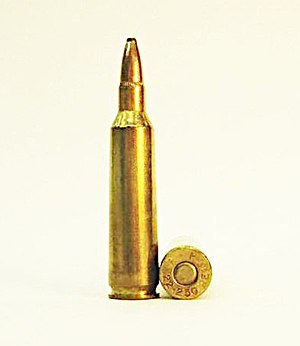.22-250 Remington
| .22-250 Remington | ||||||||||||||||||||||||
|---|---|---|---|---|---|---|---|---|---|---|---|---|---|---|---|---|---|---|---|---|---|---|---|---|
 |
||||||||||||||||||||||||
| Type | Rifle | |||||||||||||||||||||||
| Place of origin | USA | |||||||||||||||||||||||
| Production history | ||||||||||||||||||||||||
| Designer | Grosvenor Wotkyns, J.E Gebby & J. Bushnell Smith | |||||||||||||||||||||||
| Designed | 1937 | |||||||||||||||||||||||
| Manufacturer | Remington | |||||||||||||||||||||||
| Produced | 1965-Present | |||||||||||||||||||||||
| Variants | .22-250 Ackley Improved | |||||||||||||||||||||||
| Specifications | ||||||||||||||||||||||||
| Parent case | .250-3000 Savage | |||||||||||||||||||||||
| Bullet diameter | .224 in (5.7 mm) | |||||||||||||||||||||||
| Neck diameter | .254 in (6.5 mm) | |||||||||||||||||||||||
| Shoulder diameter | .414 in (10.5 mm) | |||||||||||||||||||||||
| Base diameter | .469 in (11.9 mm) | |||||||||||||||||||||||
| Rim diameter | .473 in (12.0 mm) | |||||||||||||||||||||||
| Case length | 1.912 in (48.6 mm) | |||||||||||||||||||||||
| Overall length | 2.35 in (60 mm) | |||||||||||||||||||||||
| Rifling twist | 1-12, 1-14 | |||||||||||||||||||||||
| Primer type | Large rifle | |||||||||||||||||||||||
| Ballistic performance | ||||||||||||||||||||||||
|
||||||||||||||||||||||||
| Source(s): Hodgdon | ||||||||||||||||||||||||
The .22-250 Remington is a very high-velocity (capable of reaching over 4000 feet per second), short action, .22 caliber rifle cartridge primarily used for varmint hunting and small game hunting, though it finds occasional use on deer. This cartridge is also sometimes known as the .22 Varminter or the .22 Wotkyns Original Swift. Along with the .220 Swift, the .22-250 was one of the high-velocity .22 caliber cartridges that developed a reputation for remote wounding effects known as hydrostatic shock in the late 1930s and early 1940s.
The .22-250 started life as a wildcat cartridge developed from the .250 Savage case necked down to take a .224 caliber bullet. In the early days of the cartridge there were several different versions that varied only slightly from one to the next, including one developed in 1937 by Grosvenor Wotkyns, J.E. Gebby and J.B. Smith who named their version the 22 Varminter.
The .22-250 is similar to, but was outperformed by the larger .220 Swift cartridge. However, it is in much wider use and has a larger variety of commercially available factory ammunition than the Swift. This makes it generally cheaper to shoot. The smaller powder load also contributes to more economical shooting if a person is doing their own reloads. Despite common myths regarding longer barrel life on a 22-250 vs the Swift or other calibers, that is directly related to shooter habits, allowing the barrel to cool between volleys and the speed of the bullet, an important factor for high-volume shooters. Both the Swift and the 22-250 shoot at very similar velocities and bullet weights so barrel wear when used and cooled equally is identical between the two calibers. Due to its rimless case the 22-250 also feeds from a box magazine with ease.
In 1937 Phil Sharpe, one of the first gunsmiths to build a rifle for the .22-250 and long time .220 Swift rifle builder, stated, "The Swift performed best when it was loaded to approximately full velocity," whereas, "The Varminter case permits the most flexible loading ever recorded with a single cartridge. It will handle all velocities from 1,500ft/s up to 4,500ft/s."
...
Wikipedia
